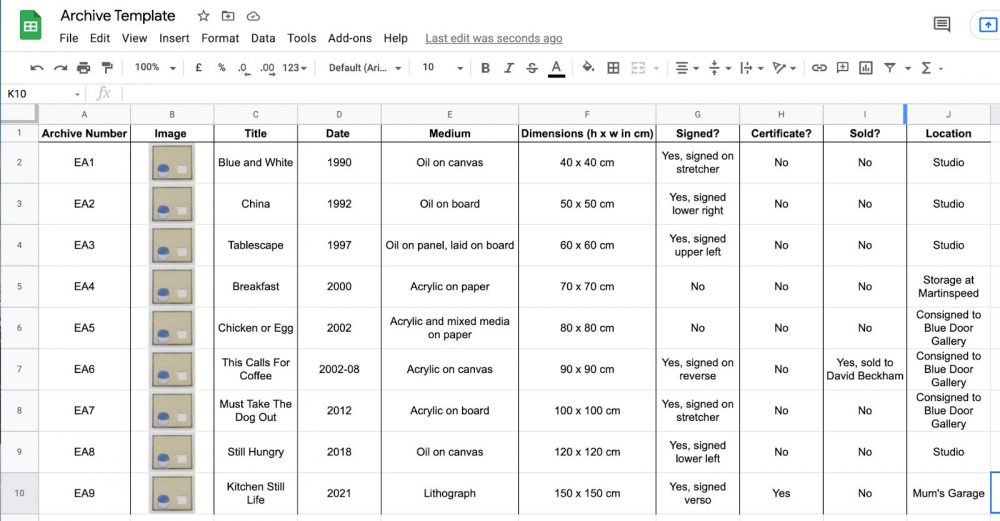If I had a pound for every time in my (relatively short thus far) career that I have received an artwork from an artist without a title, date or signature, I would already be far richer than working in the arts will ever make me.
It is not required that an artist do these things – and some have personal reasons for not doing so. I have heard artists say they do not want to title their works because they do not want viewers to observe the piece through the lens associated with the words in the title. Artists have told me to “make one up” because they do not care about titles. I have known artists to produce 20 or 30 works a year, all called Untitled, 2018/19/20.
Titles do serve an important purpose. Whether you want to sell your artworks through a gallery or independently, following these basic steps will make your art easier to identify, value, sell, authenticate and ultimately archive.
Here are a few tips for documenting your works and creating your own archive.
1. Title your works.
Even if it is just a number. Even if it is “Untitled No. 10701” (see Martin Creed’s titling strategy). If you want to be very diligent, it is even more useful to assign an archive number. That way, if you ever have another work with the same title, they are still distinguishable.
For example, an artist called Sadie Delphina could have a system like the following:
SD1 Purple Peacocks
SD2 Still Life with Marmite
SD3 Not Another Painting
It is beneficial if you put the title (and/or number) on the work somewhere, ideally on a stretcher bar or the reverse of the sheet. Alternatively, you could create labels with the title, date, edition info, and archive number that you can place anywhere on the piece. Obviously, sculptures can be more difficult to title and label, but that is where the archive numbers can be handy.
No matter how long you have been working, it is never too late to start this process. It will make it easier for you and others to handle your work down the road.
2. Date your work.
This may not seem very important in the short term. Still, for art historians, curators or galleries trying to track an artist’s career or stylistic progression, being able to date the artwork accurately is essential. If the work is completed over a series of years, you can do a range (2001-2021).
3. Sign your work.
Even if you do not want to sign the front, for whatever reason, a signature on your work may be vital if there are issues with authentication in the future. It is a common misconception that forgeries are restricted to older works (such as Old Masters and Impressionists). As printing technology gets more sophisticated, it is easier to do sophisticated forgeries, particularly of prints.
4. Include a certificate of authenticity for prints and photographs.
The certificate should confirm it is an authentic work and include the title, date, and edition number. Often certificates of authenticity will have embossed seals or will be signed by the artist.
5. Keep a photographic record.
This is becoming more commonplace as artists and galleries upload paintings to websites, Instagram, etc. However, I’ve noticed that social media has contributed to artists being lax with their filings. Treat high-resolution images of your artwork like gold. Discovering that you don’t have a high-res image and cannot track it down from the various photographers, galleries or museums that should have it can be quite devastating for an artist. While the work is not ‘lost’, the inability to refer to a good image of it in the future can be haunting. Additionally, should you, a publisher or museum, need to put together a catalogue or book of your works, having these images on hand will be vital.
These tips come from my experience working as a cataloguer and registrar. So I can personally attest to the value of having this information readily available and identifiable when an artwork is received in a gallery.
I have worked with enough artists to know that many find this side of their career either boring or daunting, which is why the administrative work is often neglected. However, as many artists are increasingly marketing themselves on their own platforms, managing inventory does become more important. I have put together a very basic template that you can use in Microsoft Excel or Google Sheets to begin a better archive practice. Of course, there are many more details you could include, so feel free to expand. I have filled the example with sample data to illustrate what it will look like and what each field is for.

*Note: while it is down to personal preference, I feel Google Sheets is the best choice for this task. In Excel, if you insert pictures in a cell and then try to filter or sort, you often find the image does not travel with the cell; and you are left with a pile of images in a spreadsheet. In Google Sheets, you can insert a picture into the cell, and it will travel with the data in the cells in that row when you sort or filter. (See video below)





